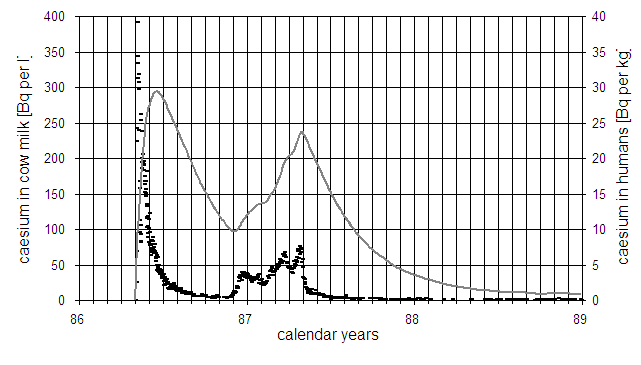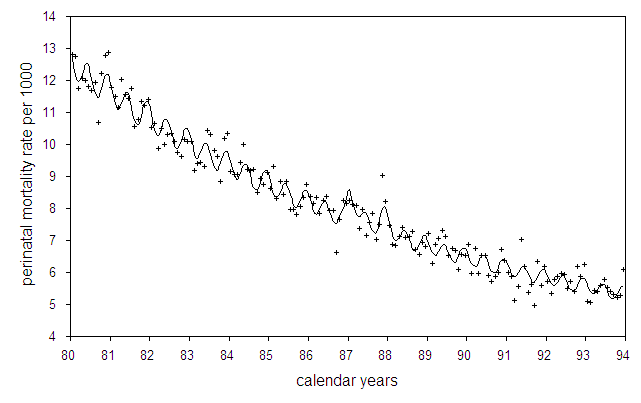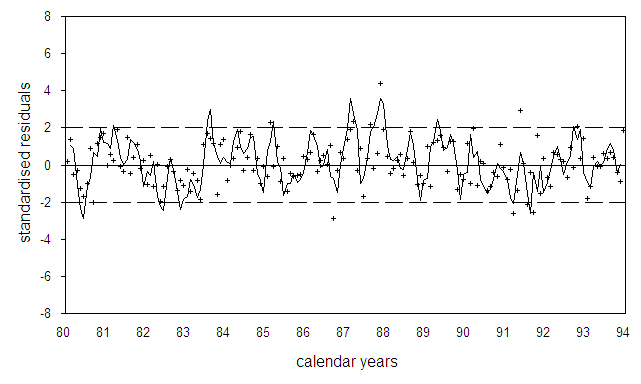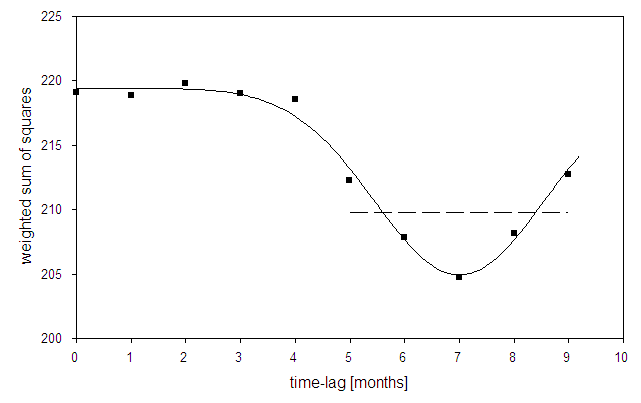Perinatal
mortality - monthly data
Model
A
model for the trend of monthly data has to allow for seasonal variations of
perinatal mortality rates. Two periodic terms with periods of 12 and 6 months
are therefore added to the long-term trend, and four additional parameters are
needed, two for the
amplitudes (β4, β6) and two for the phase shifts
(β5, β7):
E(Y(t))
= 1/(1+1/exp(β1 +β2Ět +β3Ět▓
+β4Ěcos(2piĚ(t-β5))
+β6Ěcos(2piĚ(2t-β7))))
The time variable t points to the centre of a
month, where a "month" is defined as one twelfth of a year. To avoid
large numbers, the time axis starts in 1980. May 1986, e.g., corresponds to
t=6.375.
The caesium concentration in cow milk is used
as a proxy for the total internal radiation exposure from caesium, essentially
because data of caesium contamination in cow milk were available. The caesium
concentrations in cow milk were measured at the Munich based GSF-Institute
nearly every day, from the beginning of May 1986 until the end of 1988. In the
first year following Chernobyl, the internal exposure of the German population,
mainly from caesium in cow milk, exceeded the external caesium exposure. Milk
produced in higher contaminated southern Bavaria was distributed and consumed
throughout West Germany. In Berlin, where the caesium soil contamination was
nearly 10-times smaller than in Munich, the average caesium content in
individuals was only a factor of two lower than in Munich.
The calculation of the caesium concentration
in pregnant women is based on the assumption of a constant daily milk
consumption and a somewhat reduced biological half-life of caesium of 70 days
during pregnancy. The caesium burden increases with caesium uptake and decreases
with caesium excretion. Figure 1 shows the measured caesium
concentration in milk (dots) and the calculated caesium burden in pregnant women
(solid line).

Fig.1: Caesium concentration in cow milk (short dashes) and in pregnant women
(solid line), calculated with a constant daily consumption of cow milk and a
biological half life of 70 days.
The regression model with the caesium term
has the following form:
E(Y(t))
= 1/(1+1/exp(β1 +β2Ět +β3Ět▓
+β4Ěcos(2piĚ(t-β5))
+β6Ěcos(2piĚ(2t-β7))
+β8Ě(cs(t-β10))^β9))
Parameter β8 is a constant,
β10 is the time-lag between caesium concentration cs(t) and
perinatal mortality, and β9 is the power of dose which allows
for a curvilinear dose-response relationship.
To test the significance of the caesium term,
the weighted sum of squares resulting from a regression with the full model is
compared with the sum of squares obtained from a regression without the caesium
term. An F-test is applied to test the significance of the caesium term. The
test statistic is
F = ((χ▓0-χ▓1)/(df0-df1))/(χ▓1/df1)
where χ▓0 and χ▓1 denote the weighted sum of squares under the null hypothesis and under the full model, respectively; df0 and df1 are the corresponding degrees of freedom. Here df0-df1 equals the number of parameters to be tested.
Perinatal
mortality in Germany
A regression without the caesium term yields a weighted sum of squares of 221.6 (df=161). Regressions with the full model are then performed with different time-lags β10. The best fit with a sum of squares of 204.5 (df=158) is obtained for a time-lag of 7 months. The corresponding F-test is significant (p=0.0053).
Figure
2 shows German monthly perinatal mortality rates and the long-term
trend. Figure 3 displays the deviations of the observed rates from the
calculated undisturbed trend (standardised residuals) and the three-month moving
average. There are significant peaks of perinatal mortality in the beginning and
at the end of 1987.

Fig.2: Monthly perinatal mortality rates in Germany and regression line with seasonal fluctuations

Fig.3: Deviation of monthly perinatal mortality rates in Germany from the undisturbed long-term trend of the data in units of standard deviations (standardized residuals). The solid line is the three-month moving average, the broken lines show the range of two standard deviations.
In Figure 4, the profile sum of squares is plotted as a function of the
time-lag. The broken line gives an estimate of the 95% confidence interval from
5.5 to 8.5 months based on the F-test.

Fig.4: Sum of squares as a function of the time-lag between caesium concentration in pregnant women and perinatal mortality in Germany (profile likelihood). The broken line indicates the 95% confidence interval for the time-lag ranging from 5.5 to 8.5 months.
Perinatal
mortality in Zhitomir oblast, Ukraine
The Ukrainian region (oblast) Zhitomir is the most contaminated region of Ukraine. But due to the small number of inhabitants (1.4 mio) it is not easy to detect deviations from the expected trend.
Figure 5 shows the deviations of monthly perinatal mortality rates in Zhitomir from the trend of the years 1985-1991 without 1987. There are peaks of perinatal mortality in January and in April 1987 which coincide with peaks of infant mortality peaks in Poland.

Fig.5: Deviations of observed perinatal mortality rates from the Ukrainian Zhitomir oblast (dots) from the undisturbed long-term trend in units of standard deviations (standardised residuals). The solid line is the three-month moving average, the broken lines show the range of two standard deviations.